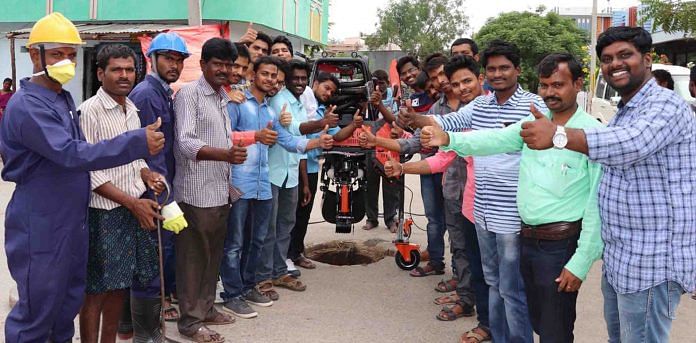Sewage workers continue to die despite manual scavenging being illegal, and the govt is accused of not doing much despite massive funding available under Swachh Bharat.
New Delhi: It has been more than four years since the Supreme Court ordered the abolition of manual scavenging — the practice of cleaning untreated human waste by hand. And yet, the age-old caste-based practice continues, and workers continue to die in sewage pits.
It’s not as though sewer cleaning technology doesn’t exist. But activists such as Bezwada Wilson, the national convener of the Safai Karmachari Andolan, insist that the government has done virtually nothing to eradicate the problem, despite its push for a Swachh Bharat over the last four years.
“Mechanisation and modernisation of sewage cleaning has been completely ignored by the government,” Wilson said.
The result is that deaths continue to pile up — the SKA estimates 221 sewage workers have died since January 2017, of which 11 cases have been reported in just the last seven days.
Technology that can solve problem
Developed countries have two main methods to loosen blockages and clear sewer drains without using manual scavengers — sewer-rodding and sewer-jetting.
Rodding involves a long metal rod rotating fast to loosen the blockage. Jetting involves a hose spraying a high-pressure jet of water to clear a sewage pipe of blockages.
Indian municipal bodies are gradually adopting machinated sewer cleaning to end manual scavenging, but at a very slow pace. Hyderabad, for example, introduced 70 mini sewer jetting machines in 2017.
Also read: Drain deaths: Cheap labour, distrust of machines keep manual scavenging alive
In Delhi, where manual scavenging has been in focus due to recent deaths, Delhi Jal Board vice-chairman Dinesh Mohaniya said the body expects to “automate sewage cleaning in the next 2-3 months”.
A manhole-cleaning robot, made in India
An Indian start-up called Genrobotics has made the world’s first manhole-cleaning robot, which it calls ‘Bandicoot’.
Arun George, co-founder of Genrobotics, told ThePrint: “It’s time to give these people their dignity. There are methods to clean sewers without a man getting into the pit.”
George said municipalities such as those in Thanjavur, Madurai and Tiruchirappalli in Tamil Nadu, Anantapur in Andhra Pradesh, and Thiruvananthapuram and Kochi in Kerala are already using the Bandicoot robot for cleaning their sewers.
The four-legged robot weighs 50 kg and cleans a manhole in a mere 20 minutes, which would take three workers 2-3 hours. The robot has a magnetic mechanism to lift the manhole lid on its own, while a technician can also lower it into a manhole to clear blockage.
It has one arm with a 360-degree rotating ability. The legs latch on to the walls inside the drainage pipe to balance the robot while the arm scrapes the sewer debris and dumps it into a bucket-like structure on the main body of the robot. It can fire a jet of water as well.
The robot comes with a feature to change the end of the robotic arm to clean different sized drainage systems like the inside of a manhole or the insides of a sewer line. The robot has cameras that work even in low light conditions to show where the blockage is, what poisonous gases are present, and the pH value of sewer water.
It works in semi-automatic and automatic modes and Genrobotics is using machine-learning technology to make it perform better in auto mode.
Is money an issue?
George said the delay in introducing mechanisation is “perhaps due to initial expenses”. His Bandicoot robot costs between Rs 18-30 lakh, depending on the features.
For an unorganised sector like sewage cleaning, which is filled with small-time contractors hesitant to bear high expenses, this is a very large sum. George cites an example from Kerala, where one municipality may pay Rs 1,500 to a contractor per manhole; the contractor, in turn, would pay Rs 500 to the labourer to clean around 3-4 manholes per day.
Also read: Sewage worker deaths wouldn’t happen if India worked as hard on it as it did for polio
Sewage workers are not provided safety gear, such as harnesses, safety jackets, gloves, boots, masks and oxygen cylinders. Paul Divakar, general secretary of the National Campaign on Dalit Human Rights (NCDHR), said the whole kit would cost not more than Rs 5,000 per worker.
That means to equip the estimated 4.5 million sewage workers in India, the total cost would be Rs 2,250 crore. In comparison, the total allocation for Swachh Bharat (rural areas) in the union budget 2018-19 was Rs 15,343 crore.
But to Wilson, the delay in mechanisation is because the government has a casteist mindset towards sewage cleaning. “It’s one caste’s job — the government is not even willing to think about it,” he alleged.







Sewage damage is the most dangerous form of water cleanup. The possibility of blood-borne pathogens and other contaminants is high. The following are basic instructions for handling a sewage water loss.
Removing sewage water and solid waste in a safe and appropriate manner;
It’s time to uplift the morale of the sanitary workers. Private engineering institutes are doing good for these workers. Govt. should let go their ego and instantly fund the project. Without these brethren at the hells holes we cannot lead a hygienic life.
Karna chahiye, on priority. Both safety gear, as an interim measure, and then mechanisation as the long term solution. There can be no higher claim on the Swachh Bharat mission, which could save a lot of money by stopping the ads.